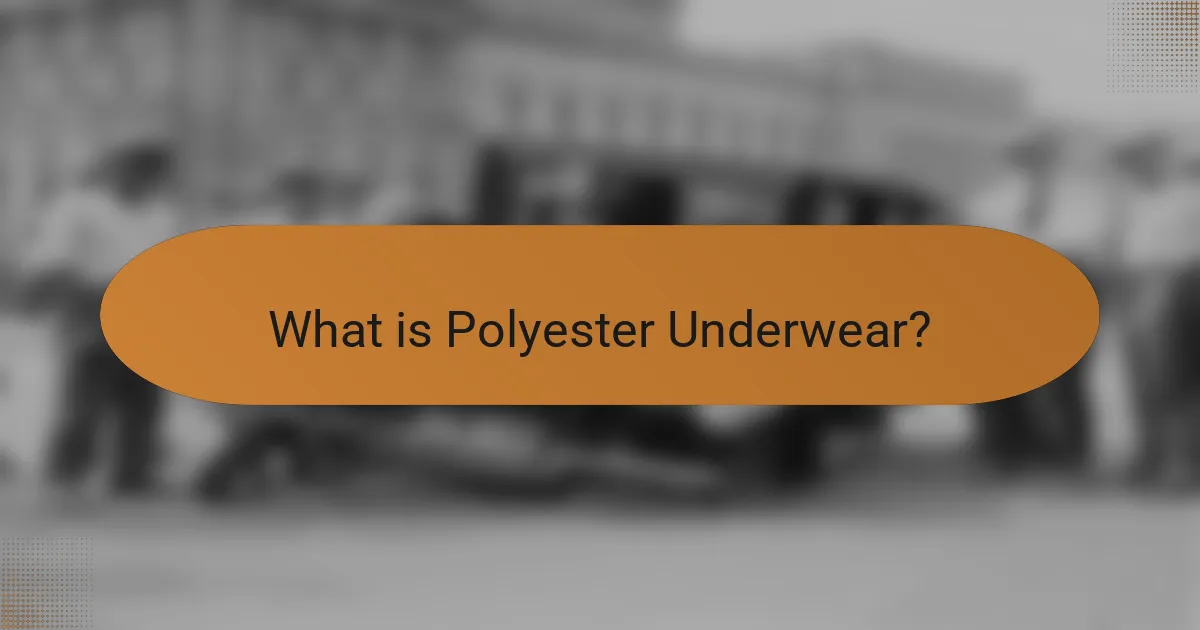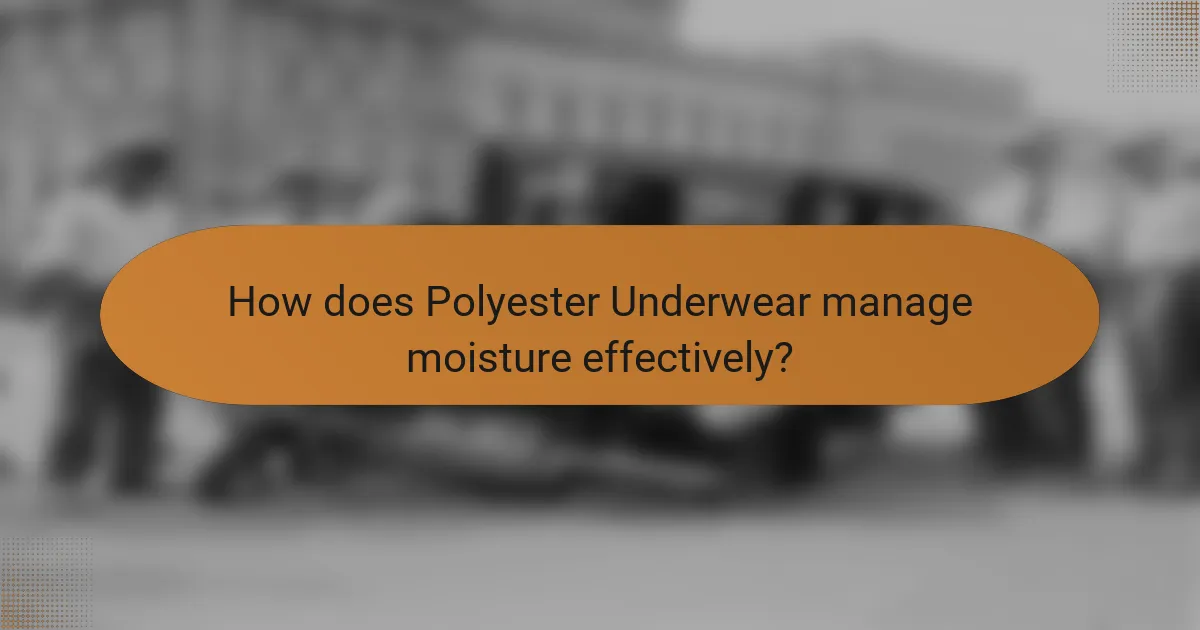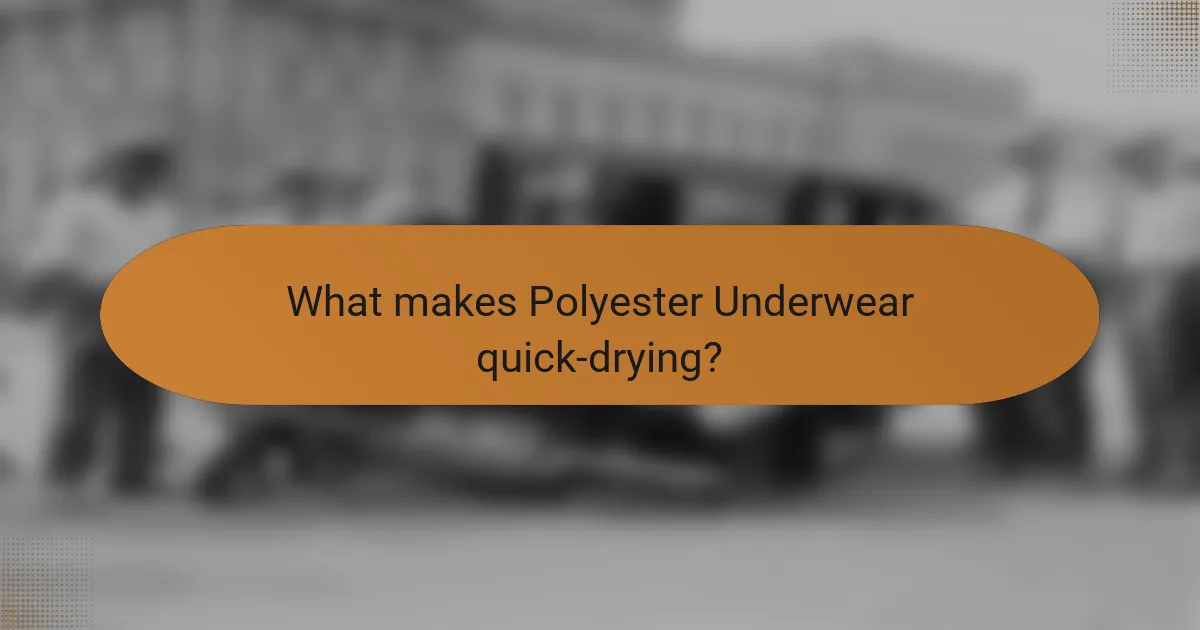Polyester underwear is a type of undergarment made primarily from polyester fibers, known for their durability and moisture-wicking properties. This fabric effectively manages moisture by repelling water and allowing sweat to evaporate quickly, making it ideal for physical activities. Additionally, polyester underwear retains color well, preventing fading and ensuring vibrant aesthetics over time. Its lightweight and quick-drying nature enhances comfort and reduces the risk of chafing, making polyester underwear a popular choice for both everyday wear and active lifestyles.

What is Polyester Underwear?
Polyester underwear is undergarments made primarily from polyester fibers. This synthetic material is known for its durability and resistance to shrinking. Polyester underwear effectively wicks moisture away from the skin. It helps keep the wearer dry during physical activities. The fabric dries quickly, making it suitable for active lifestyles. Polyester also retains color well, preventing fading over time. Its lightweight nature adds to comfort and ease of movement. These features make polyester underwear a popular choice for everyday wear and sports.
How is Polyester Underwear made?
Polyester underwear is made through a series of manufacturing processes involving polyester fibers. First, raw materials like petroleum are processed to create polyester resin. This resin is then melted and extruded through spinnerets to form long strands of polyester fiber. Next, these fibers are cooled and solidified before being cut into short lengths. The short fibers are spun into yarn, which is then knitted or woven into fabric. Finally, the fabric is treated with dyes and finishes to enhance moisture management and color retention. This process ensures that polyester underwear is durable and quick-drying, meeting the needs of consumers.
What are the raw materials used in Polyester Underwear production?
Polyester underwear is primarily produced using polyester fibers. These fibers are derived from petrochemical products, specifically through the polymerization of ethylene glycol and terephthalic acid. Ethylene glycol is obtained from natural gas or petroleum, while terephthalic acid is produced from para-xylene, a component of crude oil. The combination of these raw materials results in the creation of polyester, which exhibits desirable properties for underwear, such as moisture-wicking and durability. These characteristics make polyester a popular choice in the textile industry for producing comfortable and functional underwear.
What manufacturing processes are involved in creating Polyester Underwear?
The manufacturing processes involved in creating polyester underwear include fiber production, fabric weaving or knitting, dyeing, and finishing. Polyester fibers are produced through a polymerization process, where terephthalic acid and ethylene glycol are combined. This creates polyethylene terephthalate (PET), the primary material for polyester.
After fiber production, the next step is fabric creation. The fibers are woven or knitted into fabric, depending on the desired texture and stretch. This fabric can then undergo dyeing, where color is applied to achieve the desired aesthetic.
Finally, finishing processes are applied to enhance performance characteristics. These processes may include treatments for moisture-wicking, anti-microbial properties, and softness. Each step is crucial to ensure the final product meets quality and performance standards.
What are the key features of Polyester Underwear?
Polyester underwear features moisture-wicking properties. This allows it to draw sweat away from the body. It helps keep the wearer dry and comfortable. Polyester also retains color well. This means it resists fading after multiple washes. Additionally, polyester underwear dries quickly. This is beneficial for active individuals. The fabric is lightweight and breathable. It provides comfort during various activities.
How does Polyester contribute to moisture management?
Polyester contributes to moisture management by effectively wicking moisture away from the skin. This synthetic fabric has hydrophobic properties, meaning it repels water rather than absorbing it. As a result, sweat is drawn away from the body and evaporates quickly. This process helps maintain a drier and more comfortable environment for the wearer. Studies show that polyester can dry up to three times faster than cotton. This rapid drying capability is essential for active wear and underwear. Additionally, polyester’s durability ensures that its moisture-wicking properties remain effective over time.
What role does Polyester play in color retention?
Polyester plays a significant role in color retention due to its chemical structure. The fiber’s hydrophobic nature prevents water absorption, reducing the risk of color fading during washing. Polyester fabrics can withstand high temperatures, which helps maintain dye stability. Additionally, polyester is often treated with color-fast dyes that enhance color retention. Studies show that polyester retains color better than natural fibers like cotton. This attribute makes polyester a preferred choice for vibrant and long-lasting garments.
Why is quick-drying an important benefit of Polyester Underwear?
Quick-drying is an important benefit of polyester underwear because it enhances comfort and hygiene. Polyester fabric has low moisture absorption, allowing it to dry quickly after washing or sweating. This property helps prevent chafing and discomfort during physical activities. Additionally, quick-drying underwear reduces the risk of bacterial growth, promoting better hygiene. Studies show that polyester can dry up to three times faster than cotton. Therefore, quick-drying properties make polyester underwear a practical choice for active lifestyles.

How does Polyester Underwear manage moisture effectively?
Polyester underwear manages moisture effectively through its hydrophobic properties. This fabric repels water, preventing it from being absorbed. Instead of soaking up moisture, polyester allows sweat to evaporate quickly. The moisture-wicking capability draws sweat away from the skin. This helps keep the wearer dry and comfortable. Studies show that polyester can dry up to three times faster than cotton. This rapid drying reduces the risk of chafing and irritation. Additionally, polyester maintains its shape and elasticity even when wet.
What mechanisms enable moisture management in Polyester Underwear?
Polyester underwear manages moisture through its hydrophobic properties and breathability. The hydrophobic nature of polyester fibers repels water, preventing moisture absorption. This allows sweat to evaporate quickly from the skin. Additionally, the fabric’s structure promotes airflow, enhancing evaporation rates. Polyester’s moisture-wicking technology further aids in drawing sweat away from the body. Studies show that polyester can reduce moisture retention by up to 30% compared to cotton. These mechanisms collectively ensure comfort and dryness during physical activities.
How does wicking work in Polyester fabrics?
Wicking in polyester fabrics occurs through the hydrophobic nature of the fibers. Polyester fibers repel water, which causes moisture to be drawn away from the skin. This moisture is then spread across the fabric’s surface. The increased surface area allows for quicker evaporation. As moisture evaporates, the skin feels drier. This property is essential for activewear and underwear. Studies show that polyester can effectively manage moisture, enhancing comfort during physical activities.
What are the benefits of moisture management for active individuals?
Moisture management benefits active individuals by enhancing comfort and performance. It helps regulate body temperature during physical activities. Effective moisture management reduces the risk of chafing and skin irritations. It promotes quicker drying times, keeping the skin dry and comfortable. Studies show that moisture-wicking fabrics can improve athletic performance by maintaining optimal body conditions. Active individuals experience less fatigue due to reduced moisture accumulation. This leads to longer, more enjoyable workouts. In summary, moisture management is essential for maintaining comfort and enhancing performance in active lifestyles.
Why is moisture management crucial for comfort?
Moisture management is crucial for comfort because it regulates body temperature and prevents skin irritation. When moisture accumulates on the skin, it can lead to discomfort and chafing. Effective moisture management allows sweat to evaporate quickly, keeping the skin dry. This is particularly important during physical activities or in warm environments. Materials with good moisture-wicking properties, like polyester, draw moisture away from the skin. According to a study by the Textile Research Journal, moisture-wicking fabrics can reduce skin temperature by up to 2 degrees Celsius. Therefore, proper moisture management enhances overall comfort and performance.
How does moisture retention affect skin health?
Moisture retention significantly impacts skin health by maintaining hydration levels. Proper hydration helps to keep the skin barrier intact. A strong skin barrier prevents moisture loss and protects against irritants. When skin retains moisture, it appears plumper and more elastic. Hydrated skin is less prone to dryness and flakiness. Studies show that optimal moisture levels can reduce the appearance of fine lines and wrinkles. Additionally, moisture retention can help in healing minor skin irritations. Therefore, effective moisture management is crucial for overall skin health.
What are the implications of moisture management in various climates?
Moisture management is crucial in various climates as it affects comfort, hygiene, and performance. In humid climates, effective moisture management helps to prevent chafing and skin irritation by wicking sweat away from the body. This is essential for maintaining comfort during physical activities. In dry climates, moisture management aids in maintaining skin hydration and preventing dryness. Proper moisture management also reduces the risk of bacterial growth, which can lead to infections. Furthermore, in colder climates, moisture management is vital for thermal regulation, as damp fabric can lead to heat loss. Research has shown that materials like polyester excel in moisture-wicking properties, making them ideal for diverse climatic conditions.

What are the advantages of color retention in Polyester Underwear?
Color retention in polyester underwear provides several advantages. It ensures that the garments maintain their vibrant colors over time. This quality enhances the aesthetic appeal of the underwear. Color retention minimizes fading during washing and exposure to sunlight. As a result, users experience longer-lasting products. Studies show that polyester fabrics can retain color better than natural fibers. This durability contributes to the overall longevity of the underwear. Additionally, consistent color can boost user satisfaction and confidence in their clothing choices.
How does Polyester maintain color vibrancy over time?
Polyester maintains color vibrancy over time due to its chemical structure and dyeing processes. The synthetic fibers of polyester are less absorbent than natural fibers. This property allows the dye to adhere more effectively to the surface of the fibers. Polyester’s resistance to fading is enhanced by the use of disperse dyes, which are specifically designed for synthetic materials. These dyes are less prone to washing out or fading under UV light exposure. Additionally, polyester is often treated with colorfastness agents that further protect against color loss. Studies show that polyester fabrics can retain their color significantly longer than cotton or other natural fibers under similar conditions.
What factors influence color fading in fabrics?
Color fading in fabrics is influenced by several key factors. Exposure to sunlight causes significant fading due to ultraviolet (UV) radiation. Washing fabrics in hot water can also lead to color loss. The type of detergent used plays a role; harsh chemicals can degrade dyes. Additionally, fabric composition affects color retention. Natural fibers tend to fade more quickly than synthetic ones. The presence of moisture can accelerate fading, especially in humid conditions. Lastly, the dyeing process and quality of dyes used impact how well colors hold over time.
How does the dyeing process affect color retention in Polyester?
The dyeing process significantly influences color retention in polyester. This synthetic fiber is inherently hydrophobic, which means it repels water. During dyeing, heat and pressure are applied to facilitate color absorption. The method used, such as disperse dyeing, enhances the bond between the dye and the polyester fibers. Stronger bonds result in better colorfastness, reducing fading over time. Additionally, the quality of the dye and the dyeing conditions impact the final color retention. Research shows that properly dyed polyester can maintain its vibrancy even after multiple washes. Hence, effective dyeing techniques are crucial for achieving long-lasting color in polyester fabrics.
Why is color retention important for consumers?
Color retention is important for consumers because it ensures the longevity and aesthetic appeal of garments. Consumers prefer clothing that maintains its original color after multiple washes. This preference is especially significant in fashion items like polyester underwear. Research shows that color fading can lead to dissatisfaction and decreased product value. According to a study by the American Association of Textile Chemists and Colorists, garments that retain color have a higher customer retention rate. Additionally, vibrant colors can enhance consumer confidence and satisfaction. Therefore, effective color retention directly impacts consumer loyalty and brand reputation.
How does color retention impact the longevity of Polyester Underwear?
Color retention significantly impacts the longevity of polyester underwear. When the color of polyester fabric remains vibrant, it indicates that the fibers are not degrading. Faded colors often result from exposure to UV light, washing, and wear, which can weaken the fabric. Strong color retention suggests that the dyeing process used is effective and that the fabric is resistant to fading. This resistance contributes to the overall durability of the underwear. Studies show that high-quality dyes enhance the lifespan of polyester garments by preventing color loss. Therefore, better color retention correlates with increased longevity of polyester underwear.
What are the aesthetic benefits of color retention in fashion?
Color retention in fashion enhances the visual appeal of garments. It ensures that colors remain vibrant and true over time. This quality contributes to a polished and professional look. Garments that maintain their color can enhance the overall aesthetic of an outfit. Consistent color quality can elevate consumer satisfaction and brand loyalty. Studies show that consumers prefer clothing that retains color after multiple washes. Retaining color reduces the need for frequent replacements, promoting sustainability in fashion. This aspect is particularly important in the fast-paced fashion industry, where trends change rapidly.

What makes Polyester Underwear quick-drying?
Polyester underwear is quick-drying due to its hydrophobic nature. This fabric repels water instead of absorbing it. Consequently, moisture evaporates quickly from the surface. The structure of polyester fibers allows air to circulate efficiently. This enhances the drying process significantly. Studies show that polyester can dry up to three times faster than cotton. The lightweight nature of polyester also contributes to its quick-drying ability. These properties make polyester an ideal choice for active wear and underwear.
How does the structure of Polyester contribute to quick-drying properties?
The structure of polyester contributes to its quick-drying properties through its hydrophobic nature. Polyester fibers repel water, preventing moisture absorption. This characteristic allows moisture to evaporate quickly from the surface of the fabric. The smooth surface of polyester fibers also facilitates rapid drying. Additionally, polyester’s low moisture regain rate, typically around 0.4%, enhances its ability to dry faster than natural fibers. Studies show that polyester garments can dry up to three times quicker than cotton. This combination of hydrophobicity and low moisture retention makes polyester an ideal choice for quick-drying applications.
What is the significance of fabric density in drying time?
Fabric density significantly affects drying time. Higher fabric density means more fibers are packed into a given area. This increases the amount of moisture the fabric can hold. Consequently, denser fabrics take longer to dry. In contrast, lower density fabrics have more air pockets. These air pockets allow moisture to evaporate more quickly. Research indicates that fabric density can influence drying rates by up to 50%. Thus, understanding fabric density is crucial for optimizing drying time in polyester underwear.
How does quick-drying affect the usability of Polyester Underwear?
Quick-drying enhances the usability of polyester underwear by allowing it to dry rapidly after washing or sweating. This feature is particularly beneficial for active individuals. Quick-drying fabric reduces the discomfort associated with damp clothing. It also minimizes the risk of chafing during physical activities. Furthermore, quick-drying properties make polyester underwear ideal for travel. Travelers can wash their underwear and have it ready to wear in a short time. Studies show that polyester can dry up to three times faster than cotton. This efficiency supports prolonged comfort and hygiene in various conditions.
Why is quick-drying a desirable feature for athletes?
Quick-drying is a desirable feature for athletes because it enhances comfort and performance. When athletes sweat, moisture can accumulate on their skin, leading to discomfort and distraction. Quick-drying fabrics help wick moisture away from the body, allowing it to evaporate rapidly. This keeps athletes dry and comfortable during their activities. Studies show that staying dry can improve thermal regulation, preventing overheating. Additionally, quick-drying materials reduce chafing and irritation, which can hinder performance. In competitive environments, every advantage matters, and quick-drying apparel contributes to an athlete’s overall efficiency and focus.
What are the benefits of quick-drying for outdoor activities?
Quick-drying fabrics offer several benefits for outdoor activities. They help maintain comfort by rapidly removing moisture from the skin. This reduces the risk of chafing and irritation during physical exertion. Quick-drying materials also enhance temperature regulation. They allow for better airflow, keeping the body cooler in warm conditions. Additionally, these fabrics dry quickly after exposure to water or sweat. This prevents the wearer from feeling damp and cold, especially in cooler climates. Quick-drying properties can also lead to less odor retention. This is beneficial for extended outdoor adventures, as it allows for fresher clothing over longer periods. Overall, quick-drying fabrics improve performance and enjoyment during outdoor activities.
How does quick-drying enhance comfort during exercise?
Quick-drying enhances comfort during exercise by rapidly removing moisture from the skin. This property prevents the accumulation of sweat, which can lead to chafing and discomfort. Quick-drying fabrics allow for better temperature regulation. They help maintain a consistent body temperature during physical activity. Studies show that moisture-wicking materials can reduce skin irritation. This is particularly beneficial in high-intensity workouts where sweat production is high. Polyester underwear, known for its quick-drying capabilities, significantly improves the overall exercise experience.
What are the best practices for caring for Polyester Underwear?
Wash polyester underwear in cold water to prevent damage. Use a gentle cycle to avoid wear and tear. Avoid bleach, as it can discolor the fabric. Air drying is preferable to maintain shape and elasticity. If using a dryer, select a low heat setting. Ironing should be done on a low setting if necessary. Store in a cool, dry place to prevent mildew. Regular care extends the lifespan of polyester underwear.
Polyester underwear is a type of undergarment made primarily from polyester fibers, known for their durability, moisture-wicking capabilities, and quick-drying properties. The article explores the manufacturing processes involved in creating polyester underwear, including fiber production and dyeing techniques that enhance color retention. Key features such as moisture management, which helps keep the wearer dry during physical activities, and the advantages of quick-drying fabric for athletes and active individuals are also discussed. Additionally, the article highlights the significance of color retention in maintaining the aesthetic appeal and longevity of polyester garments.